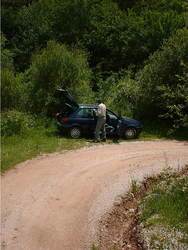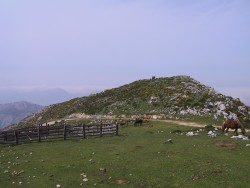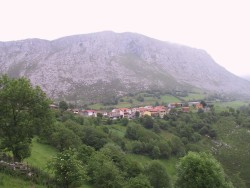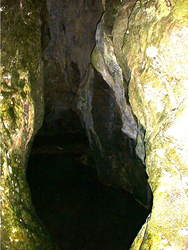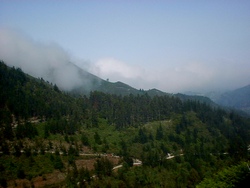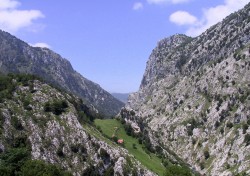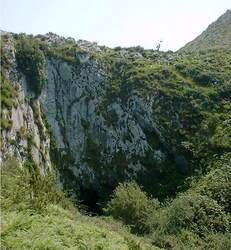

Introduction
Site list (GPS fixes) Walks (GPS tracks) Video clips Panoramas
Electronic projects:
Bat detector
Lamp tests
µ-controlled lamp
SEPIC-based lamp
ISP isolators
Making SMT boards
Expedition logs:
Spain 1973, 1974,
1975, 1976, 1977,
1979, 1982, 1983,
1985, 1986, 1987,
1988, 1989, 2000,
2001, 2002, 2003,
2004, 2005, 2006,
2007, 2008, 2009,
2010, 2011, 2012,
2013, 2014, 2015,
2016, 2017, 2018,
2019, 2020, 2021,
2022, 2023
Mexico
New England
Translation:
Expedition log, Summer 2002
A summary and index of the Speleogroup logbook.
El Mazuco, Purón/Pruneda, hikes, General Strike, Cabañuca, etc.
| Date | Activity |
|---|---|
| 13.06 | Thursday. Flight on time and we were on the road at 14:30 and arrived at the Hostal Vista Alegre just half an hour later.
Over a tinto in the hotel bar we perused the 1:25,000 map and identified
some new depressions to drive/walk to.
We took the autopista back east and turned off at Santullán and up a forest track to a large depression some 50m deep, on the south flank of Peña de Otañes, used to dump lime spoil. The depression was frequented by giant birds identified by Mike as vultures and by Bill as turkeys or ostriches. Mike’s guess turned out to be right because
Anyway, notwithstanding these flying menaces, and the imagined hopping menaces which may have been lurking in the caves, the intrepid pair proceeded on foot into the depression. Despite well-washed limestone rocks marking the torrent’s path, no real entrance lay at the bottom. However a series of substantial cave entrances had been seen at about 50m above. After a warm climb these turned out to be fossil structures – only a little more than rock shelters. A futher series of entrances below led to some minor passage “out of sight of daylight”. Total length only 50m in all, with a possible round trip via a pitch. We drove the car down the track below the depression but no sign of any resurgence was found (some fossil resurgence remnants were found at the limestone boundary). Back to Castro for a walk-around and dinner – at least three menús had chuletillas. |
| 14.06 | The long drive west, heading inland at Cabezón de la Sal to Puentenansa. Looked at nearby depression behind Pedreo – but full of fields so descent deemed unnecessary. North from Puentenansa – through road works – to find the road closed, fortunately just where we had already decided to leave the main road anyway and turn off west.
Over the hill to Toyu, looking at one long depression then exploring
a higher one; some flood debris, but no cave.
Stopped at Toyu for a picture of the sign, then south and west to La Hermida for lunch. “Authentic” axed chicken and seafood paella followed by bacon chops. On the way to La Hermida, Mike had spotted an interesting road and cueva above Roza, so after lunch we decided to backtrack and drive/walk the track while we were in the area. Beyond the village of Roza the road deteriorates to a track. Bill scraped the underside of the car a few times but progress was OK for 1 km until deep gullies in the road eventually forced us to park the car at the ‘bend’ in the road (15:30, altitude c.580m). A hot slog in the sun along the easy track of some 3km took us to the “saddle” and an enormous closed valley which should feed La Honda del Val Major. We completed the climb of ~500m in 90 minutes (17:00 1070m). We investigated a few depressions but it doesn’t look too promising. Bill had left a botle of “Champagne Cider” in a spring, and after consuming this we contoured above the track looking for the Cueva Cosandri, shown on the map as being 1030m, 1.3 km at 355° from Roza church, without success. Bill slipped twice and sent a spectacular landslide of rocks down the mountainside. We see another vulture. The descent took the same 90 minutes (due to our detours to look at depressions, etc.). Eventually back to La Hermida for a tinto and on back to Llanes, just in time for dinner. |
| 15.06 | We had been told in 2001 that in very dry weather the upstream section of Cueva de Caldueñín is passable. Evidently the weather was not very dry and a sizeable river was met as usual. However, we did explore some 20m of new (to us) passage – probably a fossil inlet?
Outstanding for years has been the locating of Pozo de Fresno (Pot of the Ash Tree) in El Mazuco. After asking the barman and several locals we found an easy track contouring around to the south and west to a meadow containing a clump of trees. There was no protection for animals which might venture near the supposedly 20 m deep pothole (explored by OUCC in 1969, see Proc OUCC 5 »). From our superficial viewpoint (holding onto tree branches and trunks for support!) we could only see a 10 m near-vertical slope onto mossy stones/boulders. For another year. Lunch in the El Mazuco bar/restaurant. A very abundant fabada for Bill and chuletillas for Mike, the latter cooked on the open grill [see photo from a later visit]. Checked out numerous side roads and holes on the way back to Llanes; met Sr. Ruiz-Sanchez in Villa and promised a photo. |
| 16.06 | East to the Purón valley, psyched-up for a long trudge up the hill. However, we were delighted to find the old very rough track is now surfaced.
Ten minutes later, and almost up to the saddle, we were stopped by ongoing roadworks (abandoned for the weekend). We left the car there and proceeded to El Cuevón de la Pruneda (known to us as Purón cave). We first took a look at the left-hand entrance, but were stopped by a deep pool. Next into the ‘wet’ entrance (where the stream enters); we followed the stream to the confluence with an inlet and then explored the extensive series (previously largely ignored) inside of the deep pool previously seen from the other entrance. Tufa and an easy climb to the right led down over dry rimstone pools to series of grottoes with some very nice stals. Total vertical range at least 15 m and at least 50 m distance – all new to us. We returned to the confluence and followed the main stream passage down until it got too wet. Mike, for experiment, used a single-LED PhotonLight “key-fob” light to exit the cave; very successful. We then had a good look at some upper, dry, ‘cow shelter’ entrances before heading up-valley to identify the route to Viango for future reference. Then back to the car for some heroic reversing by Bill to get the car down to a place where it was possible to turn. Then down the hill and (after a few false starts – one restaurant half demolished, the other closed) found a fishy lunch in San Vicente de la Barquera. Again a slow return to Llanes, for dinner. |
| 17.06 | After a trip to the bookshop to search for new maps, we found we had a gap in the Ribadesella quadrant, so decided to head west of Ribadesella to look at Cueva Rosa and its depression. Very foggy along the coast. First stop at El Carmen to look for Cueva Pedroses. After walking around a soggy orchard in the fog for a while, we eventually decided an 80 cm wall was an insuperable obstacle and returned to the car.
Cueva Rosa proved equally elusive in the fog. A direct approach from El Carmen was foiled by a mismatch between map and road, with no chance of getting bearings due to the fog. We then circled north to approach the depression from the west, only to find the farmer at La Teyes had stretched a wire across the road to prevent access. We continued around the south rim looking for routes down the 150 m depression, without success – although we did eventually complete the circumnavigation of the depression and get back to El Carmen. By now it was lunchtime, so into Ribadesella for a pleasant lunch at Mesón Miño (fabada, escalope, etc., €8 each). Despite the lack for 1:25,000 maps, we decided to look for possible tracks leading to Cueva Negra (above Tinganón). First try, from Santillanes, got a little way up the hill (to mill) but still a long walk, so we went around the mountains east to Nueva then up to Llamigo. Around Llamigo the sun came through the clouds and by the time we reached the pass the views were excellent. After a quick check of Riensena, we returned to Llamigo and tried various tracks to the north, which proved non-drivable. Back down to towards Neuva and then took the westerly track starting just north of the river bridge on the way to Nueva. The track was alongside the river for a while, but soon took off up the hill in generally the right direction. Careful driving by Bill took us a long way up the track; we stopped when it began to lose height. Returning to a previous junction with a logging track we parked the car at +270m and headed up (roughly west) towards a low saddle. From the saddle we were entertained by the sight of a tractor towing a trailor and leading a horse and a dog. The path we were on turned into a Llangattock-like grassy shelf, which took us round and north to the join of the Tinganón valley with the line of depressions to the east. Turning east up through the woods brought us to the line of depressions – investigation found a 10m ‘crack’ through trip, but not much more. By now, fog had begun to drop over the ridge to the north, so we climbed to the right (to +470m) to a fine saddle with gnarled pine trees from where we could see down to the depressions on one side and the tracks on the other. Very fine views. A cattle track to the right brought us to a classic ridge descent to the lower saddle, then circled back to the car just before fog and mist descended. Back via Posada to Llanes. El Retiro for dinner. |
| 18.06 | Bill was editing the OUCC 1970 report » on his PC (CRG) and noticed mention of a resurgence cave near La Roxia bar, in La Pereda. Unexplored! However we decided to press on inland to Fuente Dé rather than stay near the coast where bad weather was expected. (We also considered looking at and araound Pozo del Fresno.)
First stop was Potes to buy maps. On arrival at the Fuente Dé cable car the mountain peaks at ~ 1600m were in the clouds suggesting it would be wet and cold with poor visibility in the high Picos. Although the return journey would only have cost €8 each we decided to beat a retreat to a restaurant (hostal) some 3km back towards Potes for some soup/mountain stew and truchas. Then reinvestigated some side roads and old haunts with the benefit of the new maps, including Colio (up past La Parte and also to north) and San Esteban. After a long day’s driving arrived back in Llanes to find that it was raining (as expected). Very quiet evening with dinner at Siete Puertas, which opened for the season on Saturday. |
| 19.06 | A wet day. Took the long way round to La Pareda to look for the resurgence reported by OUCC as “near the Bar Roxia”. Unable to find the bar (or any locals foolish enough to be out in the rain, to ask), we checked various roads and then abandoned the search and went on to Posada for Bill’s dental checkup. Then to Ribadesella for lunch (market day). Still wet, so head inland to Arenas in hope of better weather and to reconnoitre some more possibilities.
Unfortunately by now, even in Arenas, the cloud base was down to 400m so track-bashing was pointless – although Bill did find a copy of the film Gentes sin Historia in Arena so the trip was not a total washout. Headed back to Llanes, with a stop on the way at “Cueva Geoffo” for a spot of drive-in caving so we didn’t get wet! Headlamps compete with Mike’s LED! Then checked out the depressions above Vibaño and Rales. Merluza for dinner in town. |
| 20.06 | The day of the Spanish General Strike.
Wet and gloomy. Hotel locked down: breakfast with lights off and
curtains closed so no one could see the staff working. Everything
(except the duty pharmacy) in Llanes is closed, including all the
bars and restaurants.
Off to El Mazuco to prospect the saddle beyond Pozu de Fresno. Much wet and soggy walking later, we return to the village – its bar, too, is closed for the strike. The men of the village are standing around in the square, talking seriously. Back down to the coast to hunt for food; finally find a camping bar open at El Brao – no hot food, but at least a rather stale Bocadillo de Queso was to be had. Thus refuelled, we returned to La Pareda where after asking a local we finally found the La Roxia bar (closed of course!). We followed various tracks around but no hint of the fabled resurgence/cave. Back to Llanes, where come evening all was still closed except Antonio’s Pizzaría, Sabor Latino. Only one of his staff had turned up, and the bar was packed, so it took 3 hours to be served – Bill had a pizza and Mike had fajitas – but better than no food at all... |
| 21.06 | The sun is out and the town is open! Inland to Arenas, stop to buy maps (but they didn’t have the Cabrales one!) etc. Then the north-east loop via Alles. Unpromising tracks were still 300m below the limestone wall when they became unpassable. Back to Arenas with a side trip to Oceño; the latter sits in its own limestone closed valley; no sign of a cave, but an idyllic setting. The track beyond Oceño looks passable with a good surface; worth a return visit with good maps.
Lunch in Arenas (truchas, fabada), then back to Llanes where Mike takes a 3-hour long walk east along the cliffs to Cue and Ballota to look at the blowholes and sea caves, and to take pictures of Castro Ballota. Dinner (chuletillas) in Uría. |
| 22.06 | Saturday; a sunny/hazy day so we were committed to a last day of caving! Took “inland” route via La Borbolla towards Panes with Mike mapreading along the curvy country road. The map showed a big depression above Andinas; a tell-tale stream stimulated us to drive up a track and then walk to within sight of a sizeable resurgence in woodland. This is probably only a minor system with a major complex higher under the main saddle. Need to revisit.
On to Suarías ... and beyond, up the track to Cabañuca. Our only tackle was 10 m of “washing line”, one jammer, and sundry crabs – enough for a mere 3 m pitch inside? Our thoughts of exploring the boring dry ways to the far side exit were dampened by the signs of an animal pen – possible fleas! Down the streamway we beat our retreat. A few minor scrambles over rocks and then a 10 m pitch. The bypass on the left was not initially found. On the right were multiple bolts, for ladders, probably. We needed that bypass! ... and scrambled around for some time. A major inlet leading up on the left seemed an unlikely bypass to a 10 m pitch down the streamway. But Mike found the well-worn passage and Bill proceeded to the 3+ m pitch. Quite vertical! Not really feasible with our equipment. Never mind; it was an enjoyable trip. Next time bring a ladder or full SRT gear. Late lunch in Panes (fabada and lomo for Bill, paella and truchas for Mike) – €9 each. Spent what remained of the afternoon driving to Castro Urdiales, dined well and had an early night. |
| 23.06 | Rain. Quiet drive to the airport in 35 minutes. Few Spaniards to be seen, on the morning after they were knocked out of the World Cup by S. Korea. Uneventful flights back to the UK for Bill & Mike. Mike’s caving gear arrives on the same flight as he does for the first time in 3 years! |
Personnel: Bill Collis & Mike Cowlishaw.
Other log details:
Exchange rate: 65p = 1 Euro = 166 pesetas (255 pts/GBP).
Speleogroup organizational matters:
- decide to set up Speleogroup.org website
- LED investigations – Bill
- GPS investigations – Mike
- Light reconnaisance vs. full caving expeditions? perhaps alternating?
- Hotel investigations for following year should be planned into schedule
- Casto U. only on return, now roads are better?

